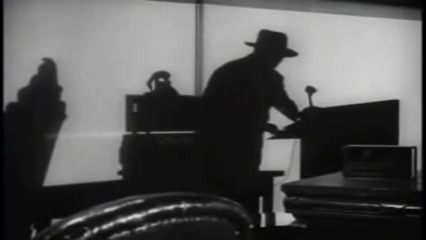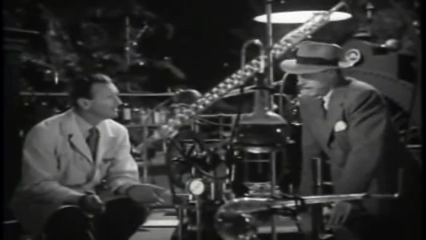-
#388 – King of the Rocket Men (1949)
King of the Rocket Men (1949)
Film review #388
Director: Fred C. Brannon
SYNOPSIS: A man calling himself Dr. Vulcan is killing off prominent scientists. After one such scientist, Dr. Millard manages to escape an attempt on his life, he goes into hiding and develops a rocket suit that allows the wearer to fly through the skies. He enlists fellow scientist Jeff King to wear the rocket suit and thwart Dr. Vulcan’s schemes.
THOUGHTS/ANALYSIS: King of the Rocket Men is a 1949 sci-fi serial. The story opens up with the mysterious Dr. Vulcan killing off members of the Science Associates, a group of top scientists. One such member, Dr. Millard, manages to escape one of Vulcan’s traps and goes into hiding, leading Vulcan to believe he is dead. While in hiding, Millard completes his invention of a rocket suit that allows the wearer to fly thanks to a jet pack. Millard enlists the help of Jeff King, another member of Science Associates to wear the suit and track down Dr. Vulcan. The story involves the usual serial tropes, with Dr. Vulcan’s true identity being hidden throughout the serial until the end, and with King figuring out the Vulcan is actually one of the members of Science Associates, he has to work out which one it is, which again is a familiar set-up for these serials. Some of the chapters provide a bit of variety, such as the one where King’s ally Ted suspecting King to be Vulcan and vice versa, which leads to an interesting confrontation, and one which I have not seen before in the serial format, but other than that its the usual back-and-forth between heroes and villains chasing each other down with various plans and traps.
The highlight of this serial has got to be the rocket suit, which allows King (and sometimes Millard) to fly through the air. This is the first serial of three to use the rocket suit, but the only to refer to the hero as “rocket man”. The other two, Radar Men from the Moon and Zombies of the Stratosphere, are all unconnected from one another, and do not give the masked hero a name. Since this serial like most is aimed at getting young viewers into the theatre each week for the next chapter, the rocket suit would definitely have been a hit with them, as there really wasn’t anything like it when it came out. Older viewers would perhaps have been less than engaged with all the usual tropes being wheeled out, but the serial isn’t really for them. There’s plenty of other inventions shown throughout the serial which are interesting enough to change up the pacing, but ultimately it does rely on the tried and tested serial elements.
The end of the film also deserves note, as in some sense the villain wins. Dr. Vulcan steals a device known as the Decimator, and uses it on a tectonic fault-line, causing a huge tidal wave that essentially destroys Manhattan. The footage of the tidal wave is taken from the 1931 film Deluge, in which a rising of sea levels causes most of the world’s population to be wiped out. The destruction looks good and devastating, and it still holds up despite being made nearly twenty years earlier, but obviously if you’ve seen it before it lessens its impact being used a second time here. Nevertheless, it’s very unlikely viewers of this serial would have seen it being used in Deluge due to the time elapsed and there being no re-runs or home releases back then. King manages to eventually stop Dr. Vulcan, but after New York City has been destroyed, and the serial ends with the ambiguous promise to rebuild New York ‘better than ever’. Not exactly a solid resolution, but these serial never are after investing nearly three hours watching them. King of the Rocket Men was released in 1949, after the serial format had peaked, but there were still some good ones being released (most notably the Superman serials, which were quite popular, and some of the best examples of the format). “Rocket man” is somewhat a superhero, with his flying ability and masked persona, and this no doubt would have made the serial stand out, but a lot of the other elements of the serial are pretty standard for the format. Overall it’s a little more interesting than the average serial, but not outstanding.









